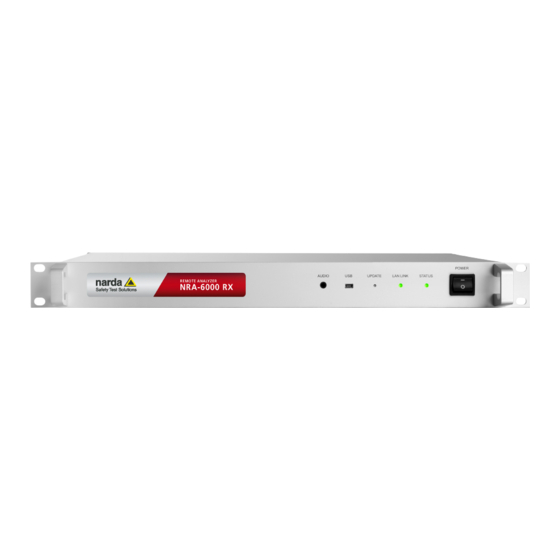Advertisement
Quick Links
Narda Remote Spectrum Analyzer, NRA Series
Interference and Direction Analyzer, IDA Series
Technical Note TN101
Capturing IQ data with
NRA and IDA
A brief theoretical outline with
practical examples
With the Scope/IQ option, the NRA and IDA instruments allow you to
generate IQ data from the received data and display, demodulate, and
store them, and transmit them block by block or as a continuous stream
via a remote interface. What, though, is the significance of this I/Q data?
What are they used for? And, how are they obtained using NRA and
IDA?
Communications systems
To transmit data wirelessly it must be modulated onto a suitable, usually
high frequency, carrier signal. This gives a basic setup as shown in
figure 1. The demodulator must perform exactly the opposite function to
the modulator. The receiver must also be able to cope with the
impairments to the modulated signal that are added as it passes through
the communications channel.
The type of modulation has to be suitable for the signal content and the
communications channel. Various techniques are used to transmit
different signals together through the same medium and then separate
them again, e.g.:
Frequency multiplex,
Time multiplex and / or
Code multiplex
The following types of modulation are commonly used for sinusoidal
carriers:
AM, FM, PM, (angle modulation) for analog signals
ASK, FSK, PSK, APSK, QAM for digital signals
If a prominent but unknown signal in the spectrum is to be classified or
even its message content reconstructed, various parameters such as
TN_IDA_1068_E_IQ data
Communications
channel
Modulator
Transmitter
Figure 1: Basic setup for a communications system
See last page for abbreviations
1 / 8
Demodulator
Receiver
Subject to change
Advertisement

Summary of Contents for NARDA NRA Series
- Page 1 Narda Remote Spectrum Analyzer, NRA Series Interference and Direction Analyzer, IDA Series Technical Note TN101 Capturing IQ data with NRA and IDA A brief theoretical outline with practical examples With the Scope/IQ option, the NRA and IDA instruments allow you to...
- Page 2 the type of modulation need to be determined before a matching receiver can be produced for the unknown transmitter. This is not possible “on the fly”, so the NRA and IDA provide facilities for recording (I, Q) the unknown signal in the form of IQ data so that it can subsequently be subjected to a more precise investigation.
- Page 3 The IQ data find application in the transmitters and receivers in communications installations. They are also suitable for recording signals from the communications channel itself. Signal under consideration From the point of view of a basic communications installation – as depicted in figure 3 –...
- Page 4 Recovering the IQ data: How it is done in NRA and IDA NRA and IDA combine analog and digital techniques for signal analysis: a classic heterodyne receiver for pre-selection is followed by a digital analyzer for fine selection and further processing. To help you understand IQ data recovery, the block diagram can be simplified as follows: Figure 5: Simplified block diagram of NRA and IDA for...
- Page 5 Example 1: IQ data captured with IDA In this example, the signal is a 16QAM signal; this is in fact not known at the start of the measurement. The signal can be seen in Spectrum mode (figure 6). The center frequency and bandwidth must be entered to tune the IDA to the signal.
- Page 6 Example 2: IQ data captured with NRA A 16QAM signal is also used here as an example of how the IQ data are USB/LAN captured using the NRA. Transfer of the data to a PC can be done in block mode using the “Scope-Demo”...
- Page 7 Example 3: Evaluation by constellation diagram The data captured from example 1 or 2 can now be analyzed on the PC, for example by generating a constellation diagram. The sample points are shown as a vector diagram in figure 9. The values are scaled by level;...
- Page 8 © 2013 Narda Safety Test Solutions GmbH ® The n ame and logo are registered trademarks of Narda Safety Test Solutions GmbH and L-3 Communications Holdings, Inc. – Trade names are the trademarks of their respective owners. TN_IDA_1068_E_IQ_data 8 / 8...

















Need help?
Do you have a question about the NRA Series and is the answer not in the manual?
Questions and answers